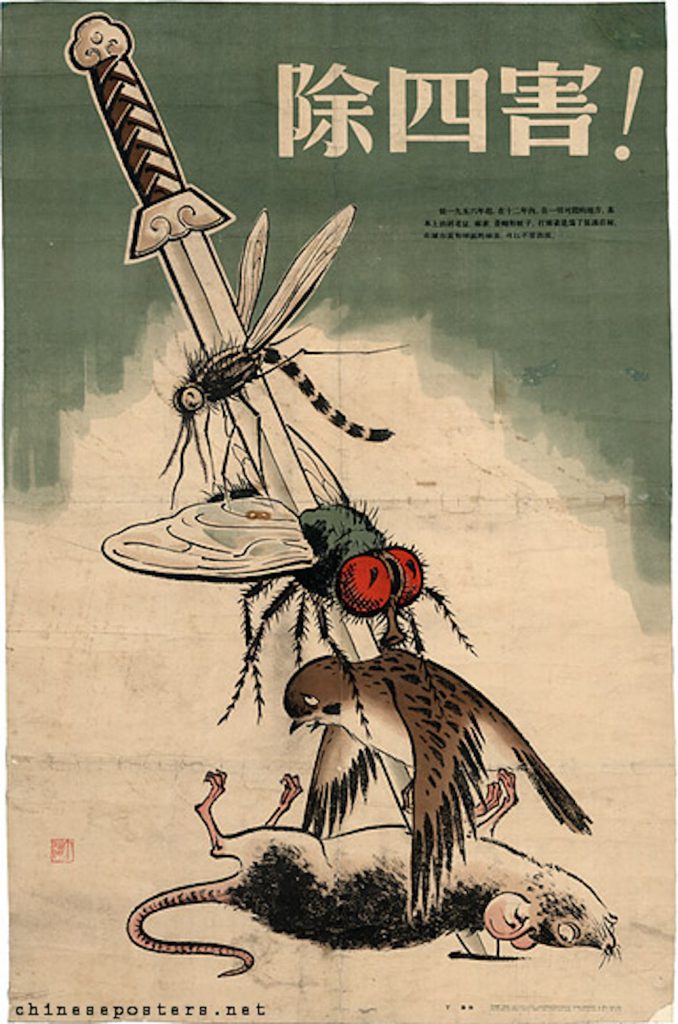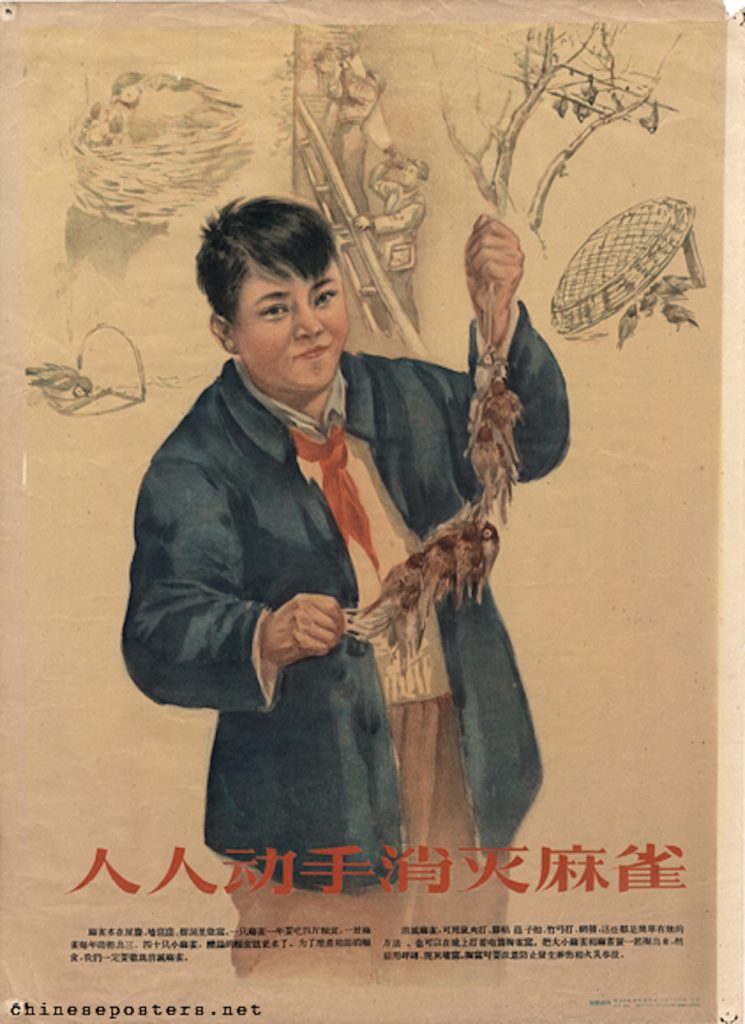At about five inches in length and weighing less than an ounce, the Eurasian tree sparrow is a little brown bird, with a short black beak, a cheerful chirp, and no defense against the bigger birds that want it for dinner. The sparrow pecks at grain and seed and lice and spiders and centipedes and other little bugs it can find to eat.
“According to ancient Chinese books,” explained a former Chinese Communist Party (CCP) role-model student, “within the food chain, sparrows eat harmful insects, but they also eat rice crops. So as long as you protect the rice crops, you will be fine.”
The thought of little birds tweeting and flying about was a pleasant distraction.
“When I was little,” he continued, “society was eliminating four pests or four ‘evils.’ Sparrows were deemed a pest, so it was decided to eliminate all the sparrows.”
Sparrow-cide? That just sounded stupid. It had to be an error. I wondered if the translator wasn’t keeping up with the incredibly fast speech of this very articulate man who had always been an active thinker. He had been touted as a model for CCP students in his youth, gained master degrees in engineering and applied mathematics, and later received a doctorate of philosophy in China studies in the West. He was able to apply for the official title of professor in China, but instead chose intellectual freedom outside the mainland, so I chose to call him the Chinese Professor for short.
The Chinese Professor had warmed up in the interview and was now pouring out his memories at such a fast rate that it required intense concentration on my part.
“But the CCP wants to do things differently to the old ways. So it wants to destroy all the sparrows,” he said.
“That’s ridiculous,” I blurted out, stopping him in his tracks. But he barely took a breath and responded immediately:
“It’s not that the CCP doesn’t know that destroying sparrows will cause problems. This is the CCP’s methodology. It wants to use these methods to add continual struggle to people’s lives. So, you are told it is necessary to eliminate sparrows.”
Again, the term struggle. That word would continue to trouble me for years to come. But for now, I just couldn’t get past the little brown birds.
“I don’t know this story,” I told him. “You have to explain it to me.”

He described lines of trucks piled high with mountains of dead little birds.
It sounded so absurd, but he was telling the truth. Fact-checking his story later proved how ignorant I was of one of the worst environmental disasters in history.
Where is the media and educational materials on that? I thought. Especially now, when political environmentalism is a top priority global agenda item in public education, why aren’t we taught about the results of perhaps the most extreme environmental catastrophe ever?
“Why did everyone agree to kill the sparrows?” I asked the Professor.
“At that time, people had been brainwashed by the CCP to just the right degree and they believed everything the CCP said.”
It was true. And I found no shortage of primary evidence.
I looked at full-color posters declaring death to those nasty, pestilent, evil sparrows. I watched black-and-white, yet clear-as-day footage of public parades, complete with sign boards and model animals on posts, calling for death to the little birds. I saw the “gloriously heartwarming” activity of people of all ages working together to bring death to the little birds.
I saw men and youths aim and fire at them with pistols and slingshots. I searched for evidence of the birds shot down by balls or bullets but I didn’t find any. Perhaps the precision of China’s 1950’s weapons were not accurate enough for untrained peasants to shoot the tiny targets very well, or perhaps no evidence of that method of killing exists because a bullet going through a little brown bird would leave little more than a little, bloody mess.
Mostly the masses yelled and screamed at the sparrows. People became living scarecrows, swatting at the birds with long sticks and branches. As soon as a little bird perched anywhere to take a rest to calm its pounding heart and catch the breath in its tiny lungs, the masses would scream and yell and swat and harass again — over and over and over — until the little bird finally dropped dead in the dirt from exhaustion. One by one, they all dropped dead. And this happened again and again and again, all across the nation.
In the excitement of their success in the struggle against nature, masses of people gathered sparrow upon sparrow and tied their little bodies together, forming long, brown, feathery braids.
In single file, the braids were presented to seated communist officials who recorded the official count of the dead to report to higher authorities. The larger the number of dead birds, the greater the praise from the CCP. It is likely that those areas that didn’t present enough dead little birds were somehow penalized, but I didn’t search hard enough to find any evidence to prove that.

Perhaps some unlucky little birds were only exhausted and not dead. If they did awaken, being tied together, they would eventually die of hunger. Or perhaps they would be crushed, or suffocated beneath the giant sparrow hills that were driven off in rows of trucks into the sunset of a communist heaven.
There is no exact number of how many sparrows were originally living in China in that year of 1958. But it is estimated that hundreds of thousands were killed. Had there been a sparrow for each person in the nation, there would have been more than 600 million. But by the end of the same year, very few sparrows remained.
“Then what happened?” I asked the Professor.
“The next year, the crops were destroyed by insects. All the crops in all the places without sparrows had barely a single grain of food to harvest. Insect borne disease became severe and people had to starve again.”
I learned what Chinese people do not learn and are not allowed to learn in China: Up to 45 million men, women, and children died of mass starvation in the devastating famine that followed the sparrow-cide. It was far worse than an environmental disaster. It is the worst recorded mass starvation in history. Yet in China, this is not taught. It is not even spoken of. And although we in the West have relatively easy access to information about it, it is hardly even common knowledge here.
The disaster was compounded by man-made socialist design. New and untested agricultural policies were imported from Soviet Russia, and throughout China all farmers were mandated by the CCP to use the new Soviet farming techniques. It was another Marxist method to struggle with nature, and to destroy the old time-proven methods and implement the new.
The new techniques were a complete and utter failure, and compounded the problem created by the sparrow-cide.
Worst of all — and what is never mentioned in China — there was food and grain piled high in many large storehouses. And it was intentionally left to rot, or was exported to other countries as foreign aid to give the false perception of a booming Chinese economy.
Of course, CCP officials didn’t starve. They fed themselves, while millions of citizens were forced to die slowly and painfully from malnutrition and starvation, desperately eating anything they could — from dirt and sawdust to leather, and even family members who were either murdered and eaten, or exhumed and consumed from their graves.
I am wrong to say that the sparrow-cide and famine are not spoken of in China. It is allowed to be mentioned, but only within the confines of the communist language and culture, which I came to learn doesn’t require any honesty or accurate representation. Therefore, such a disaster can only be mentioned as a euphemism — a more pleasant-sounding word that waters down or hides the truth.
In the sparrow-cide example, a human being who holds honesty as an integral value in their culture would describe the famine as a mass starvation of millions of people, or something to that effect. Yet a human being who is beholden to communist culture is prevented from using terms that value honesty above political needs. So they call the mass starvation of millions of people a “natural disaster.” Yes — a natural disaster.
Chinese history books, teachers, and therefore students refer to this period in history as: The Three Years of Natural Disaster. And with a benign term like that, teachers have been taught to disassociate honesty from truth, and this has been passed on to generation after generation of Chinese students who have grown up to be the mainstay of Chinese society. They not only don’t know the real cause behind the tragedy of the little brown birds, they believe that it was never a tragedy at all.
This article is a chapter from the book, “Who Are China’s Walking Dead?” (Liberty Hill Press, 2020) written by author and filmmaker, Kay Rubacek, and republished with permission from the author. Copyright Swoop Films.
The views expressed in this article are the opinions of the author and do not necessarily reflect the editorial stance of LiCAS.news.






